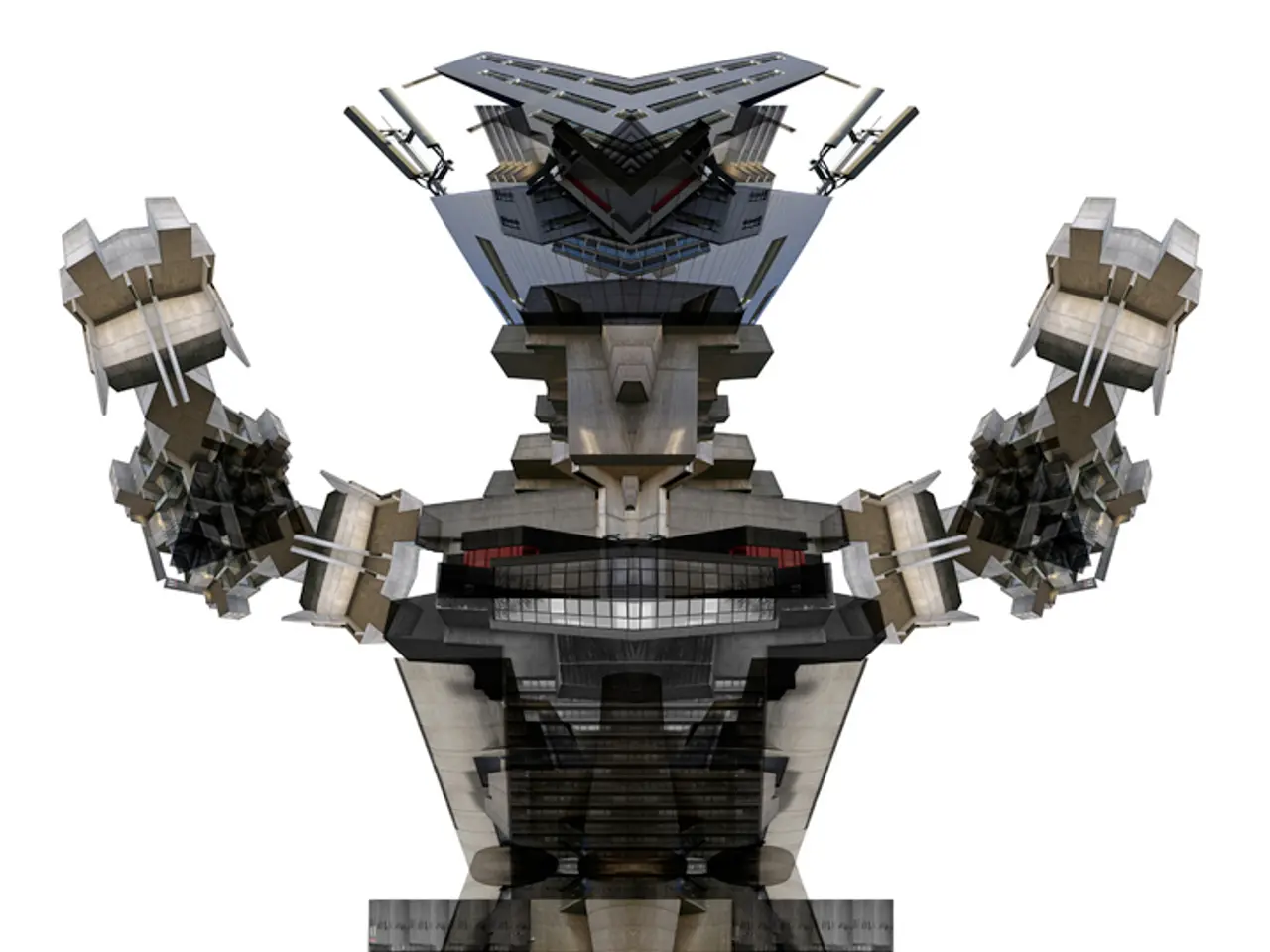Improving diagnostic methods for enhanced accuracy
The world of medical diagnostics is undergoing a significant transformation, with the integration of artificial intelligence (AI) and robotics playing a pivotal role. In the past decade, the average price of an industrial robot has halved, and further significant price reductions have been forecast, making these technologies more accessible to the healthcare sector [1].
One of the key players in this field is Nvidia, who recently launched the Isaac for Healthcare Medical Device Simulation Platform. This platform is designed to support the development of technologies involved in robotic surgery and digital imaging, paving the way for advancements in minimally invasive procedures [2].
In the realm of robotic surgery, Intuitive Surgical, a US robotics and biotechnology company, has developed the Ion Endoluminal System. This mechanically controlled robotic tool, with an ultrathin design and advanced maneuverability, allows for the identification of very small spots or lesions within hard-to-reach areas of the lung [3]. The Ion Endoluminal System is currently being used by doctors at Wythenshawe Hospital in south Manchester, UK.
Another innovative company, Endiatx, has developed a pill-sized robot with motors that allow the orientation of the robot and the camera on it to be controlled remotely as it passes through a patient's body. This remote control capability enables the robot to obtain the images and data needed by the clinician as part of the diagnostic process [4].
Developers of AI-powered and robotic tools are seeking patent protection to secure a 20-year period of exclusivity to profit from their commercialisation in key global markets. Investing to build a robust patent portfolio in the area of AI-powered robotic diagnostic and surgical solutions could generate significant value in the future [5].
However, the development of these AI-based platforms has not been without challenges. A lack of high-quality training data has been a significant hurdle, but access to new banks of simulated or synthetic training data has provided a breakthrough [6]. The use of such training data in the development of surgical robotic tools and other devices used for invasive clinical applications is a source of controversy [7].
AI-powered analytical models used in clinical diagnosis can outperform a general physician, but not match the nuanced capability of a medical expert with specialist knowledge [8]. Transparency-enhancing platforms that allow clinicians and patients to understand AI decision-making—moving beyond "black-box" models—are helping build trust and accountability in clinical settings [9].
Despite these challenges, the acceptance of these AI diagnostic tools by patients is generally positive but nuanced. Clinical tools combining AI and robotics are augmenting clinicians' capabilities by automating routine, time-consuming analysis and enabling earlier, more accurate diagnoses, which leads to better patient outcomes [1][2][5].
GE HealthCare intends to use the Isaac for Healthcare Medical Device Simulation Platform to build autonomous imaging systems comprising both X-ray and ultrasound hardware, which is controlled by robotic arms that respond to a patient's position using machine vision technologies [2].
In summary, AI-powered diagnostic robotics are advancing rapidly and gaining traction in healthcare, with growing patient acceptance linked closely to transparency, accuracy, and integration into clinical workflows. As these technologies continue to evolve, they are set to revolutionise the field of medical diagnostics, offering faster, more personalised, and more accurate diagnoses for patients worldwide.
[1] The average price of an industrial robot has halved in the decade to 2022, and further significant price reductions have been forecast. [2] Nvidia has launched the Isaac for Healthcare Medical Device Simulation Platform to support the development of technologies involved in robotic surgery and digital imaging. [3] Intuitive Surgical, a US robotics and biotechnology company, has developed the Ion Endoluminal System, a robotic bronchoscopy that uses advanced imaging technology for the diagnosis of lung cancer. [4] AI-powered models are particularly efficient in diagnosing dermatological conditions, but far less accurate when identifying gastroenterological issues. [5] This remote control capability enables the robot to obtain the images and data needed by the clinician as part of the diagnostic process. [6] Software can be patentable, despite common assumptions to the contrary, according to the UK Intellectual Patent Office (UKIPO) and the European Patent Office (EPO). [7] Samuel Bateman and Chris Froud are senior associates and patent attorneys, respectively, at European IP firm Withers & Rogers. [8] Medtech innovators must ensure they know where opportunities exist and what the market is ready to accept, particularly in the area of AI-powered robotic diagnostic and surgical solutions. [9] The Ion Endoluminal System is currently being used by doctors at Wythenshawe Hospital in south Manchester, UK. [10] Endiatx, a US company, has developed a pill-sized robot with motors that allow the orientation of the robot and the camera on it to be controlled remotely as it passes through a patient's body. [11] Developers of AI-powered and robotic tools are seeking patent protection to secure a 20-year period of exclusivity to profit from their commercialisation in key global markets. [12] Investing to build a robust patent portfolio in the area of AI-powered robotic diagnostic and surgical solutions could generate significant value in the future. [13] It is important to extract all valuable intellectual property for AI-powered and robotic innovations by seeking patent protection for the constituent technologies and flagging that they can be used together. [14] Repurposing is a trend in the MedTech industry, as highlighted in the article "MedTech: Repurposing is here to stay" in "Medical Device Manufacturing Insights". [15] A study published in Nature has shown that AI-powered analytical models used in clinical diagnosis can outperform a general physician, but not match the nuanced capability of a medical expert with specialist knowledge. [16] A lack of high-quality training data has been a challenge in the development of useful AI-based platforms for device developers. Access to new banks of simulated or synthetic training data has provided a breakthrough. [17] The use of such training data in the development of surgical robotic tools and other devices used for invasive clinical applications is a source of controversy. [18] Both Bateman and Froud specialize in advising innovative companies and developers in electronics and computing. [19] The Ion Endoluminal System is a mechanically controlled robotic tool with an ultrathin design and advanced maneuverability, allowing it to identify very small spots or lesions within hard-to-reach areas of the lung. [20] Early-stage projects have shown AI-powered robotic solutions to be accurate and reliable in some areas, but their suitability for widespread clinical use is still being evaluated. [21] GE HealthCare intends to use the platform to build autonomous imaging systems comprising both X-ray and ultrasound hardware, which is controlled by robotic arms that respond to a patient's position using machine vision technologies.
- As AI-powered and robotic tools continue to revolutionize healthcare, science, and technology, companies like Nvidia and GE HealthCare are investing in digital health solutions to create advancements in patient care, such as robotic surgery and digital imaging platforms.
- In the medical-conditions domain, AI-powered analytical models have demonstrated significant accuracy in diagnosing certain conditions, outperforming general physicians, but still falling short of matching the nuanced capabilities of medical experts.
- To address challenges in AI-based platform development, such as the lack of high-quality training data, developers are integrating new banks of simulated or synthetic training data to pave the way for improved health-and-wellness outcomes and technologies.




